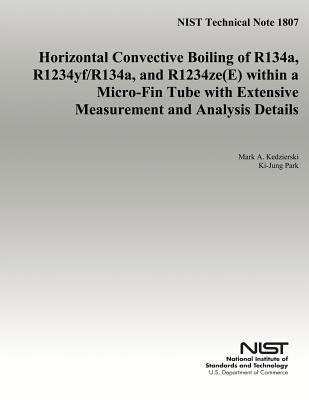
- We will send in 10–14 business days.
- Author: U S Department of Commerce
- Publisher: CreateSpace Independent Publishing Platform
- Year: 2014
- Pages: 58
- ISBN-10: 1500312061
- ISBN-13: 9781500312060
- Format: 21.6 x 28 x 0.3 cm, softcover
- Language: English
- SAVE -10% with code: EXTRA
Horizontal Convective Boiling of R134a, R1234yf/R134a, and R1234ze(E) within Micro-Fin Tube with Extensive Measurement and Analysis Details (e-book) (used book) | bookbook.eu
Reviews
Description
Internally enhanced tubes, like the micro-fin tube, are used by most manufacturers in the construction of evaporators and condensers for new unitary refrigeration and air-conditioning equipment. The reason for the micro-fin tube's hold on unitary equipment is that it provides the highest heat transfer with the lowest pressure drop of the commercially available internal enhancements (Webb and Kim, 2005). Most of the experimental measurements for evaporative heat transfer coefficients in the micro-fin tube have been done for traditional refrigerants like R134a. Pressure from the policies set by the Montreal Protocol (1987), the Kyoto Protocol (1997) and the European Mobile Directive (2006) have caused a recent shift to refrigerants with both zero ozone depletion potential (ODP) and low global warming potential (GWP). Johnson et al. (2012) reports that azeotropic R1234yf/ R134a (56/44) (i.e., XP10) 1 and R1234ze(E) are among the low-GWP refrigerants identified for evaluation by the Air-Conditioning, Heating, and Refrigeration Institute (AHRI) Low-GWP Alternative Refrigerants Evaluation Program as potential replacement refrigerants for R134a. The reason for this is that both R1234yf/ R134a (56/44) and R1234ze(E) have zero ODP and 100 year GWPs of approximately 600 and 6, respectively (Hickman, 2012 and Bitzer, 2012). Consequently, flow boiling heat transfer data for the micro-fin tube with R1234yf/ R134a (56/44) and R1234ze(E) are essential for the evaluation of their use for unitary applications.
EXTRA 10 % discount with code: EXTRA
The promotion ends in 20d.17:02:49
The discount code is valid when purchasing from 10 €. Discounts do not stack.
- Author: U S Department of Commerce
- Publisher: CreateSpace Independent Publishing Platform
- Year: 2014
- Pages: 58
- ISBN-10: 1500312061
- ISBN-13: 9781500312060
- Format: 21.6 x 28 x 0.3 cm, softcover
- Language: English English
Internally enhanced tubes, like the micro-fin tube, are used by most manufacturers in the construction of evaporators and condensers for new unitary refrigeration and air-conditioning equipment. The reason for the micro-fin tube's hold on unitary equipment is that it provides the highest heat transfer with the lowest pressure drop of the commercially available internal enhancements (Webb and Kim, 2005). Most of the experimental measurements for evaporative heat transfer coefficients in the micro-fin tube have been done for traditional refrigerants like R134a. Pressure from the policies set by the Montreal Protocol (1987), the Kyoto Protocol (1997) and the European Mobile Directive (2006) have caused a recent shift to refrigerants with both zero ozone depletion potential (ODP) and low global warming potential (GWP). Johnson et al. (2012) reports that azeotropic R1234yf/ R134a (56/44) (i.e., XP10) 1 and R1234ze(E) are among the low-GWP refrigerants identified for evaluation by the Air-Conditioning, Heating, and Refrigeration Institute (AHRI) Low-GWP Alternative Refrigerants Evaluation Program as potential replacement refrigerants for R134a. The reason for this is that both R1234yf/ R134a (56/44) and R1234ze(E) have zero ODP and 100 year GWPs of approximately 600 and 6, respectively (Hickman, 2012 and Bitzer, 2012). Consequently, flow boiling heat transfer data for the micro-fin tube with R1234yf/ R134a (56/44) and R1234ze(E) are essential for the evaluation of their use for unitary applications.


Reviews